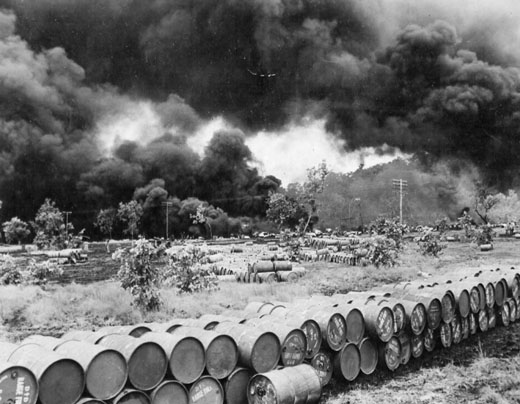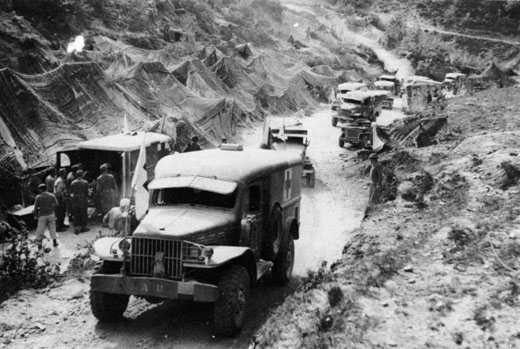Air Operations, Aleutians
3 28th Composite Bomb Group B-25s, 13 343rd Fighter Group P-38s, and 24 P-40s mount 7 separate attacks against Kiska.
[Air Operations, Bismarcks
43rd Heavy Bomb Group B-17s and 90th Heavy Bomb Group B-24s attack the Gasmata airfield on New Britain and the Rabaul-area airfields, shipping off Rabaul, and targets of opportunity at Talasea and Ubili.
[Air Operations, CBI
BURMA- 9 341st Medium Bomb Group B-25s attack the airfield at Magwe.
- 51st Fighter Group P-40 fighter-bombers attack dumps at Walawbum.
- 23rd Fighter Group P-40s strafe motor vehicles near Loiwing.
Air Operations, Europe
US 9th AIR FORCEITALY:
- B-24s of the IX Bomber Command's 376th Heavy Bomb Group sent to attack Naples harbor turn back due to bad weather. Half the group returns with bombs aboard, but the remaining planes attack targets of opportunity at Cosenza and Crotone.
- A second mission is mounted lated in the day, also by the 376th. Naples is attacked, as is the briefed secondary, Pizzo.
Air Operations, Mediterranean
NASAF B-17s attack Axis ships in the Straits of Sicily.
[Air Operations, New Guinea
- 43rd Heavy Bomb Group B-17s and 90th Heavy Bomb Group B-24s attack the airfields at Lae and Nubia, port facilities at Bogia, Madang, Nubia, and Toel, and shipping in Hansa Bay.
- 43 G4M 'Betty' bombers and 131 fighters mount a heavy attack against Port Moresby. 3 B-25s, an RAAF Beaufighter, and several fuel dumps are destroyed on the ground, and runways at three airfields are cratered. V Fighter Command fighter pilots down 17 'Bettys' and 10 fighters between 1012 and 1120 hours. 2 P-39s are lost in the air and several small vessels are damaged.
Air Operations, Sicily
NASAF B-17s attack the harbor at Trapani.
[Air Operations, Solomons
2 individual XIII Bomber Command B-24s attack the Kahili airfield on Bougainville during the evening.
[Air Operations, Tunisia
- NASAF B-17s attack Bizerte harbor.
- NATBF A-20s and B-25s attack Oudna and Ste.-Marie du Zit Airdromes.
- NAAF fighters mount numerous attacks on Axis ground forces and installations throughout northern Tunisia.
- 1st Fighter Group P-38 pilots down 4 Luftwaffe fighters in a morning action just the west of Tunis about 0800 hours.
Eastern Front
The German radio announces the discovery of eight communal graves in the Katyn forest near Smolensk, containing the remains of 4,150 Polish officers deported by the Russians in 1940 and murdered. The story says they were all shot in the back of the neck with their hands tied. The USSR denies the accusation. The truth has never been established.
SOVIET COMMANDThe Soviets begin the large-scale mobilization of civilian labor to dig hundreds of miles of trenches and defense works in teh Kursk salient. The Stavka has already identified this area as the most likely location of a renewed German offensive in the summer. By the end of the month more than 150,000 men and women are at work digging trenches and tank traps, while the Voronezh and Central Fronts lay minefields and construct elaborate anti-tank positions. The Stavka has, after considerable deliberation, decided to fight a defensive battle before unleashing its own counteroffensive.
[Germany, Strategy
Hitler issues Operational Order No 6 for the destruction of the enemy forces in the Kursk salient. Codenamed Operation CITADEL, it will begin on May 3. Hitler realizes that 1943 is his last chance to avoid defeat in the East, a position made more urgent by the impending defeat of Axis forces in North Africa, U-boat losses in the Atlantic and the threat of an Allied invasion of Western Europe. Thus, Germany's ultimate fate depends on a favorable outcome on the Eastern Front in 1943. The Führer believes that if the Soviets can be exhausted, they will be more receptive to a negotiated separate peace.
[New Guinea
The Japanese air offensive continues with attacks on Port Moresby, where the port installations are damaged, but not seriously.
Attack on Allied Airfields near Port Moresby |
 |
North Africa
TUNISIABy the afternoon the Axis troops have dug in on the Enfidaville line. The attacks by the 8th Army continue, and the Allies occupy Sousse, the last supply port on the Tunisian coast. Now only Enfidaville separates the 8th Army from Tunis.
It is agreed that the US II Corps will remain under the command of the 18th Army Group rather than the British 1st Army, but the 1st Army is to issue the necessary orders for the US II Corps in order to co-ordinate its operations with 1st Army's drive on Tunis.
In the British 8th Army area, Gen Montgomery, in response to a request from Gen Alexander for reinforcements for the British 1st Army, selects the 1st Armored Div and the King's Dragoon Guards for the mission. The X Corps captures Sousse and continues northward.
In the British 1st Army's V Corps area, the US 9th Div begins the relief of the 46th Div. The 78th Div continues clearing the region northwest of Medjez el Bab.
AFS Ambulances Delivering Patients from the Front |
 |
Pacific
The US submarine Flying Fish (SS-229) sinks the Japanese merchant cargo ship No. 12 Sapporo Maru (2865t) at the eastern entrance to Tsugaru Strait, just off Shiriyazaki, northern Honshu.
[